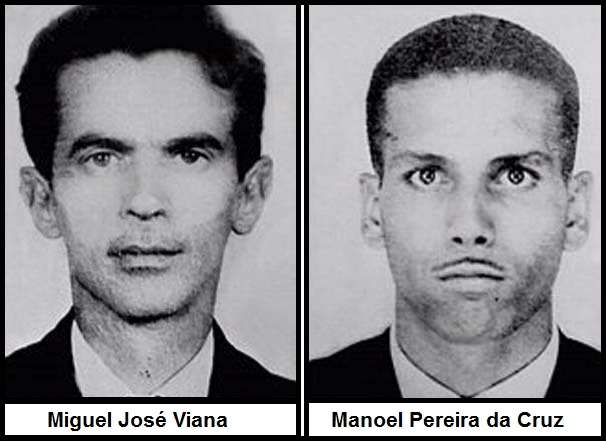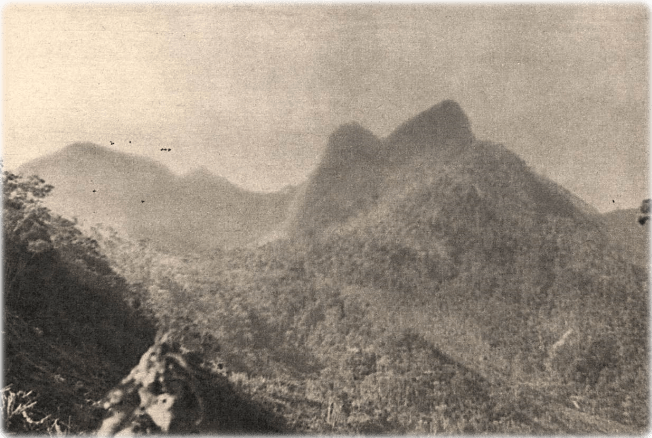“On a sweltering August day in 1966, the bizarre discovery on Vintém Hill launched one of Brazil’s most enduring and perplexing unsolved mysteries: the case of the lead masks.”
UncutCore Analysis: The Third Man, The Signal, and The Vintém Hill Sacrifice

1. THE FATAL JOURNEY: The Last Known Movements of Two Men with a Fortune
You are a witness to a quiet, meticulous preparation for death.
The year is 1966. The place is Campos dos Goytacazes, Brazil. Manoel Pereira da Cruz (32) and Miguel José Viana (34) are local electronics technicians—respected, married, and known for their shared, intense obsession with spiritualism and the transmission of radio signals to higher intelligence. Their history is important, as it reveals not men seeking death, but men seeking contact.
On Wednesday, August 17, 1966, they bid farewell to their families, stating they were traveling to São Paulo to purchase electronic parts for their small repair business and possibly a new car. They were not traveling light or unprepared; they carried a substantial sum of money: an estimated Cr$ 3,000,000 in cash (a massive amount for the time, equivalent to thousands of modern US dollars), intended for their purchases.
The Timetable of the Condemned:
- 9:00 AM, Aug 17: They board the bus from Campos.
- 2:30 PM, Aug 17: They arrive in Niterói, Rio de Janeiro. They are seen purchasing heavy, waterproof raincoats, despite the weather being relatively clear. Why? Perhaps they anticipated an abnormal weather event, or more chillingly, something that required shielding.
- 3:15 PM, Aug 17: They visit a local bar, Bar São Jorge. They buy one empty bottle of mineral water, paying only for the water and keeping the receipt to claim the deposit back on the empty bottle. Miguel Viana is noted by the waitress to be “very nervous,” compulsively checking his wristwatch. The final seconds are ticking down.
- 3:30 PM, Aug 17: They are seen walking toward Morro do Vintém (Vintém Hill), the desolate, overgrown hill that would become their tomb.
The Twist of the Tale: They carried enough cash to buy a house, yet they meticulously saved the deposit receipt for a water bottle. This contradictory behavior suggests either extreme financial prudence or, more likely, a calculated performance to prove they did not intend to die—a performance for someone watching them, or for the authorities who would inevitably find them.

2. THE SCENE OF THE RITUAL: Masks, Coats, and the Abandoned Fortune
Now, you stand on Vintém Hill, four days later, on August 20.
The air is thick, not just with the humid Brazilian heat, but with a terrible, sickly-sweet odor of decay. A young kite flyer, Jorge da Costa Alves, has stumbled upon a sight that will define Brazilian true crime for generations.
The bodies of Manoel and Miguel lie side-by-side. They are neat. They are composed. They are horrifyingly out of place.
They are meticulously dressed in their formal suits, topped by the heavy waterproof coats—a baffling choice for a warm afternoon. Their hands are placed behind their necks, suggesting a relaxed or, perhaps, a restrained posture.
But the eyes—their eyes are the focus. Each man wears a crude, diamond-shaped mask cut from sheet lead, secured with strips of wire. These are not protective goggles; they are blindfolds—shields against something expected. They lay dead, guarding their eyes from a signal that either never came, or killed them when it did.
The Evidence Stack:
- Lead Masks: Primitive radiation shields.
- Empty Water Bottle & Wet Towels: Used to mix or ingest something.
- Missing Money: The thousands of dollars meant for purchases are gone, suggesting a third party was involved in stripping the scene.
- The Cryptic Note: The final, hand-scrawled schedule, found nearby.
The Twist of the Tale: While we now know the large sum of cash they carried was missing, the original police report noted that one man still had $4,000 and the other $157 in his pockets. This incomplete robbery—leaving some cash but taking the majority—points not to a common mugging, but to a cleanup operation by an accomplice who wanted the death to look like a mystery, not a robbery.
3. THE UNNAMED SIGNAL: The Contradictions in the Final Note
The notebook page found near the bodies is the only direct statement from the victims. It confirms their intention was to survive and receive a ‘signal.’
The Final Directive (Translation):
“16:30 estar no local determinado.” (4:30 PM: Be at the specified location.)
“18:30 ingerir cápsulas, após efeito proteger metais aguardar sinal mascara.” (6:30 PM: Ingest capsules, after effect protect metals await signal mask.)
This is the version most commonly cited. However, later analysis reveals a crucial contradiction, possibly indicating multiple sources or an intentional alteration:
- Contradiction 1 (Time): Some reports, including those cited by later investigators, claimed the time for capsule ingestion was 7:30 PM (19:30), not 6:30 PM. This one hour difference is massive when dealing with lethal drug dosages.
- Contradiction 2 (The Capsules): Another note was discovered detailing drug use: “One capsule on Sunday after lunch; one capsule on Wednesday before retiring.” This suggests the use of the ‘capsules’ was not a one-off event but a scheduled regimen leading up to the final event.
The Twist of the Tale: The handwriting on the cryptic note did not match the handwriting of either Manoel or Miguel. This singular fact shatters the theory of ritual suicide. The note was written by a THIRD PARTY—the person who gave them the schedule, the capsules, and the false promise of contact. This individual directed their final actions, making this a clear case of murder, meticulously disguised as a spiritual accident.
4. THE UNSEEN WITNESS: The 1966 UFO Encounter
If this was just murder, why the lead masks and the cryptic code? The answer lies in the sky above Niterói.
On the very day Manoel and Miguel began their fateful ascent—August 17, 1966—a high-society woman from the Fonseca area, Senora Gracinda Barbosa Coutinho da Sousa, was driving with her three children.
You hear the sudden scream of a child in the back seat.
Senora Sousa slammed the brakes. Hanging silently over a nearby hill, which later was confirmed to be Morro do Vintém, was an astonishing sight:
“An oval-shaped object, of an orangy color, with a band of fire around its edges, sending forth rays in all directions.”
For four minutes, the family watched the object rise and fall vertically before vanishing. Senora Sousa’s husband initially tried to keep the story quiet to protect his wife, but upon reading the news of the Lead Masks Case, he immediately reported the sighting to the police. The hill the object hovered over was the exact same hill where the bodies were found.
The Twist of the Tale: The police, already determined to close the case as quickly as possible, were forced to acknowledge the sighting. The Brazilian government, under the 1960s military regime, had a policy of downplaying or forbidding discussion of UFOs. This governmental silence fueled local speculation: The police were actively covering up evidence of extraterrestrial contact or a classified experiment gone wrong. The victims had achieved contact—or were collateral damage—and the state was now cleaning up the narrative.
5. THE PATTERN OF LEAD MASKS: The Mysterious 1962 Precedent
The Lead Masks Case was terrifying because it felt unique. But was it?
In the weeks following the Vintém Hill discovery, a dark rumor surfaced in the local press—a story the police never confirmed, but which fed the terror of a pattern.
Four years earlier, in 1962, a TV technician named Hermes was allegedly found dead on a hill called Morro do Cruzeiro near Neves. The staggering detail? He, too, was discovered wearing a lead mask.
You recognize the disturbing pattern:
- Victims: Electronics/TV technicians with knowledge of radio waves.
- Manner: Found dead on a desolate hill.
- Signature: Wearing a lead mask.
The Twist of the Tale: Was there a single, isolated killer targeting electronics enthusiasts? Or was this evidence of a secret society or cult that convinced members to undergo a dangerous ‘initiation ritual’ involving psychoactive capsules and radiation shielding? The existence of this rumored 1962 precedent transforms the 1966 event from a single baffling mystery into a terrifying, unsolved series of ritualistic killings.
6. THE OFFICIAL COVER-UP: The Vallée Investigation and Missing Truth
The police closed the case: Cause of death was ruled inconclusive, generally accepted as “heart failure.” They found no poison, despite the decomposition.
This verdict was unacceptable to the public. In 1980, over a decade later, the renowned French UFO investigator and former colleague of J. Allen Hynek, Jacques Vallée, personally flew to Brazil to investigate the scene.
The Evidence of the Clean-Up:
- The Bare Spot: Vallée was taken to the exact site where the men were found. His guide pointed out that the ground was still strangely bare, with no vegetation growing back normally—suggesting an environmental contamination or perhaps radiation exposure at the exact point of death.
- The Unnamed Witness: Vallée met a new witness, a grown man who was one of the first people to see the bodies. This man insisted the bodies were not decomposing when found, and their skin was pink—not decayed—suggesting they had been killed very recently or suffered burns.
- The Missing Proof: Vallée claimed his guide showed him crushed pieces of aluminized blue and white paper and cellophane soaked in a chemical solution—evidence that was never included in the original police files.
The Twist of the Tale: Vallée’s investigation confirms that the police either failed spectacularly or deliberately suppressed evidence pointing toward a high-energy event (the bare ground, pink skin, radiation-like burns) or a chemical ritual (the soaked cellophane). The “official report” was a whitewash, leaving the third man—the note-writer, the supplier, the unseen participant—free to disappear into the vastness of Brazil.
7. UNCUTCORE CONCLUSION: The Final Theory – The Third Man as THE CULPRIT
The case is not an Unsolved Mystery; it is a Solved Murder that was never prosecuted.
The Core Theory: Manoel Pereira da Cruz and Miguel José Viana were not attempting suicide; they were the unwitting victims of a Fraudulent Spiritual Rite perpetrated by an accomplice:
THE CULPRIT: The Con Man/Cult Leader (The Note-Writer).
The Final Sequence of Events:
- The Setup (The Promise): The culprit—the “Third Man”—convinced Manoel and Miguel that he had achieved a method to contact extraterrestrial or spiritual beings using an electrical/psychedelic combination. He likely instructed them to bring the large sum of cash as a “fee” or “offering” for the encounter.
- The Ritual (The Murder): They followed the schedule set by the culprit (The Note-Writer). At the specified time (18:30 or 19:30), they ingested the “capsules”—a lethal dose of a fast-acting poison or drug, such as a potent psychedelic or even cyanide, which causes cardiac arrest without external trauma.
- The Masks (The Alibi): The masks were intended to provide a post-mortem narrative—a dramatic sign that the men died awaiting a signal that never came, thus obscuring the poisoning.
- The Clean-Up (The Betrayal): The culprit remained on the hill. As the men died, he took the bulk of the cash, leaving behind the small amounts and the water receipt to confuse police. He ensured the scene was composed and left before the bodies began to rapidly decompose in the heat.
Final Verdict: The ultimate culprit is the unidentified Third Man who wrote the cryptic note. His motive was Financial Gain and Control, masking a premeditated murder as a bizarre, ritualistic death.
The Enduring Mystery: While the identity of the culprit is known only to the silent Morro do Vintém, the bizarre accessories—the lead masks—ensure this case will forever be remembered, not as a murder, but as Brazil’s most chilling Unsolved Mystery.
Why were the victims in the Lead Masks Case wearing masks?
Was the cause of death ever determined in the Lead Masks Case?
CORE Case File: The Isdal Woman Mystery (1970)

